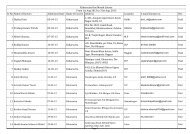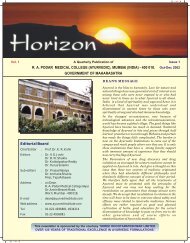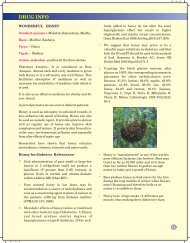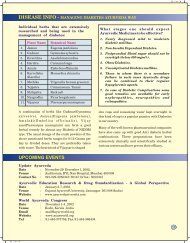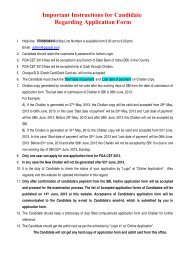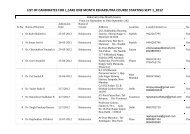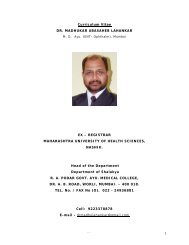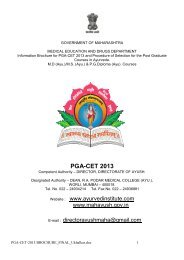Prameha in terms of Diabetes Mellitus, Metabolic syndrome and ...
Prameha in terms of Diabetes Mellitus, Metabolic syndrome and ...
Prameha in terms of Diabetes Mellitus, Metabolic syndrome and ...
- No tags were found...
Create successful ePaper yourself
Turn your PDF publications into a flip-book with our unique Google optimized e-Paper software.
THE JOURNAL OF ALTERNATIVE AND COMPLEMENTARY MEDICINE D**i/i*%iii/ A *"fi**I*\ +Volume 17, Number 6. 2011, pp. 491-496 riGVIGW MiUClGSMary Ann Liebert, Inc.DOI: 10.1089/acm.2010 0396<strong>Prameha</strong> <strong>in</strong> Ayurveda:Correlation with Obesity, <strong>Metabolic</strong> Syndrome,<strong>and</strong> <strong>Diabetes</strong> <strong>Mellitus</strong>.Part 1-Etiology, Classification, <strong>and</strong> PathogenesisHari Sharma, MD, DABP, FCAP, FRCPC. DABHM,' <strong>and</strong> H.M. Ch<strong>and</strong>ola, MD (Ay), PhD?AbstractBackground: Obesity, metabolic <strong>syndrome</strong>, <strong>and</strong> diabetes meilitus are <strong>in</strong>creas<strong>in</strong>g <strong>in</strong> epidemic proportions globally. <strong>Prameha</strong> is a <strong>syndrome</strong> described <strong>in</strong> the ancient Ayurvedic texts that <strong>in</strong>cludes cl<strong>in</strong>ical conditions <strong>in</strong>volved <strong>in</strong>obesity, prediabetes, diabetes mellitus, <strong>and</strong> metabolic <strong>syndrome</strong>.Materials <strong>and</strong> methods: Integrat<strong>in</strong>g the theory <strong>and</strong> modalities <strong>of</strong> Ayurveda <strong>in</strong> the management <strong>of</strong> these disordersmay prove to be beneficial. Kven though <strong>Prameha</strong> is a Yridoshaja Vyadhi (a disease <strong>in</strong>volv<strong>in</strong>g all three <strong>of</strong> thepsychophysiologic pr<strong>in</strong>ciples known as Doshas [i.e., Vatu, Pitta, <strong>and</strong> Kapliaj), it is basically a disease with Kaphapredom<strong>in</strong>ance.Results: There are 20 subtypes <strong>of</strong> <strong>Prameha</strong> due to the <strong>in</strong>teraction <strong>of</strong> the three Doshas <strong>and</strong> 10 Diiblu/us (disturbedfunction<strong>in</strong>g <strong>of</strong> the pr<strong>in</strong>ciples that support the various bodily tissues); several <strong>of</strong> these subtypes have sweetur<strong>in</strong>e, whereas some <strong>of</strong> them have different coloration <strong>of</strong> the ur<strong>in</strong>e, highlight<strong>in</strong>g the <strong>in</strong>flammatory conditions<strong>in</strong>volved <strong>in</strong> the metabolic <strong>syndrome</strong>. This disease has close ties to Sthauhja (i.e., obesity). With regard todiabetes mellitus, Sahaja <strong>Prameha</strong> <strong>and</strong> jatah Prnmchi correlate with type 1 diabetes; Apaihyanimittaja <strong>Prameha</strong>correlates with type 2 diabetes. Madhumeha is a subtype <strong>of</strong> Vtittija Prameita (<strong>Prameha</strong> with Vata predom<strong>in</strong>ance)that can occur as the term<strong>in</strong>al stage <strong>of</strong> type 2 diabetes (<strong>in</strong> which <strong>in</strong>sul<strong>in</strong> is required), or as type 1 diabetesbeg<strong>in</strong>n<strong>in</strong>g <strong>in</strong> early childhood. The latter is def<strong>in</strong>ed as jatali Pramehi Madltutneh<strong>in</strong>o <strong>in</strong> Charaka Samhita, one <strong>of</strong> theclassical Ayurvedic texts.Conclusions: Various dietary, lifestyle, <strong>and</strong> psychologic factors are <strong>in</strong>volved <strong>in</strong> the etiology <strong>of</strong> <strong>Prameha</strong>, particularly<strong>in</strong> relation to disturbances <strong>in</strong> fat <strong>and</strong> carbohydrate metabolism. The ancient Ayurvedic knowledge regard<strong>in</strong>gPramehn can be utiliz.ed to exp<strong>and</strong> the current underst<strong>and</strong><strong>in</strong>g <strong>of</strong> obesity, metabolic <strong>syndrome</strong>, <strong>and</strong> diabetes.Introduction Etiological Classification <strong>of</strong> <strong>Prameha</strong>O , ,. , , .... Nidana is the branch <strong>of</strong> Ayurveda that addresses theHtsiTY, mei Asouc SYN0ROM1-, <strong>and</strong> diabetes mellitus arc .. ... _. . - n ,<strong>in</strong>creas<strong>in</strong>g <strong>in</strong> epidemic...proportions.globally., , ,.Ai/urveda. , etioloevc , &'or,,disease., .,I..he.etiology. . byc.<strong>of</strong> <strong>Prameha</strong> is discussed' @<strong>in</strong>., e L i f. . , j. f ... r% , Sushruta Samhita, which identifies two types <strong>of</strong> <strong>Prameha</strong>:describes a set or cmnplex cl<strong>in</strong>ical disorders with Irequcnt . .. ,1 @,t -t-, --,11 .-f -H - -]|| >d Pnmidhi wh'-h ^al"Va' which is hereditary, <strong>and</strong> Apathyammtttaja, which ba "wrmn nm un ion, lo (i i\ y . J( , , . ,<strong>and</strong> dUibcte nu-llitus.'<strong>in</strong>t^rat<strong>in</strong>s Hu- theury .md ,@,dalitics ^"o"0S"' mi''""1"18 """"''"7 ^ """ d"C ' S1"@tic<strong>of</strong> Ayurveda <strong>in</strong> the management <strong>of</strong> these disorders may proveto be beneficial (see Sharma <strong>and</strong> Ch<strong>and</strong>ola, Ayurvedic Con- ^ , . @ l, ,. , @ ,. ,c,,, . \ . , ,. .., ,' . -. , .. ... Sahaja <strong>Prameha</strong>/Jatah Pramehi (Hereditary)cept <strong>of</strong> Obesity, <strong>Metabolic</strong> Syndrome, <strong>and</strong> <strong>Diabetes</strong> <strong>Mellitus</strong>' ' yi<strong>in</strong> this issue, pp. 000-000). The etiology, classification, path- In Ayurveda, the words Sahajti <strong>and</strong> jatah <strong>in</strong>dicate geneticogenesis, <strong>and</strong> m(<strong>in</strong>ag*?ment <strong>of</strong> Rnunchu are discussed at length predisposition <strong>in</strong> the pathophysiology <strong>of</strong> disease. Broadly, <strong>in</strong><strong>and</strong> <strong>in</strong> detail <strong>in</strong> the Ayurvedic texts. hereditary diseases there may be two contribut<strong>in</strong>g factors:'Center for Integr.itivu Mi-dicim- .md Di-partmont <strong>of</strong> Pathology. CoHe^e <strong>of</strong> Modic<strong>in</strong>e, '11iet,)]uo Suite University, Culunilnib, OH.2Institute for Tost Graduate Teach<strong>in</strong>g & Research <strong>in</strong> Ayurveda, Gujarat Ayurved University, Jamnajiar, India.'



